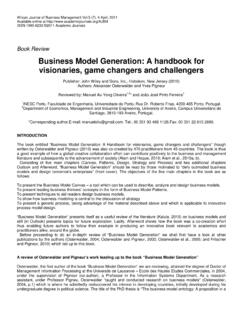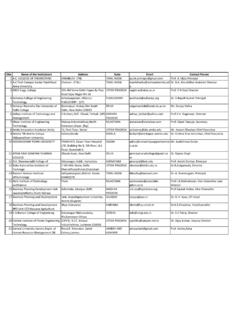Transcription of Trichoderma: Mass production, formulation, quality control ...
1 Vol. 9(53), pp. 3838-3852, 31 December, 2014 DOI: 9061 Article Number: CC4D79D50124 ISSN 1991-637X Copyright 2014 Author(s) retain the copyright of this article AJAR African Journal of agricultural Research Review Trichoderma: Mass production, formulation, quality control , delivery and its scope in commercialization in India for the management of plant diseases Sanjeev Kumar1*, Manibhushan Thakur2 and Archana Rani3 1 Department of Plant Pathology, College of Agriculture, Jawahar Lal Nehru Krishi Vishwavidyalaya-Jabalpur (MP), 482004, India. 2 Department of Plant Pathology, College of Agriculture-Dumroan, Buxar (Bihar) 802136, India. 3 Department of agricultural Biotechnology and Molecular Biology, (FBS & H), Rajendra agricultural university , Pusa-848125 (Bihar), India. Received 11 August, 2014; Accepted 17 November, 2014 Popularization of biopesticides is very slow as compared to chemicals and only 2% biopesticides are available.
2 Among the different biopesticides, Trichoderma is most exploited and have many success stories. Trichoderma viride and Trichoderma harzianum have curved a niche for themselves in India as important biocontrol agents for management of various diseases. A number of successful products based on different species of Trichoderma have been commercialized in India. The potential Trichoderma isolates are formulated using different organic and inorganic carriers either through solid or liquid fermentation technologies. They are delivered either through seed treatment, bio-priming, seedling dip, soil application, and foliar spray. Application of Trichoderma formulations with strain mixtures perform better than individual strains for the management of pest and diseases of crop plants, in addition to plant growth promotion.
3 Commercialization of the bioproducts is primarily hindered due to the poor shelf life. Hence, research should be concentrated to increase the shelf life of the formulation by developing superior strains that support the increased shelf life, or the organic formulations that support the maximum shelf life with low level of contaminants must be standardized for making biocontrol as a commercial venture. Whatever the limitations these Trichoderma products may have, it can be addressed by enhancing biocontrol through manipulation of the environment, accurate strain identification by molecular approach, using mixtures of beneficial organisms, physiological and genetic enhancement of biocontrol mechanisms, and manipulation of formulations.
4 Of late, many small and large entrepreneurs have entered into the commercial production of bio control agents resulting into the entry of various bio- control products into the world market. Key words: Trichoderma, mass production, formulation, shelf-life, commercialization. INTRODUCTION The green revolution has led to intensified agriculture to meet the ever increasing demands for food and fiber globally. Nevertheless, this also damages the natural ecosystems by polluting the ground water and food stuffs *Corresponding author. Email: Author(s) agree that this article remain permanently open access under the terms of the Creative Commons Attribution License International License besides degrading the environment. Plant diseases are one of the major concerns in cultivation worldwide consequential in loss of billions of dollars of farm produce.
5 There is a pressing need to manage diseases to make sure a steady and constant supply of marketable produce for the escalating world population. In disease management, the amplified use of chemicals have caused negative impact on environmental quality and resulted in upward trend of many living forms which are resistant to the chemicals (Kumar and Gupta, 2012). Under the changing agriculture scenario, the only technology that seems promising to manage the diseases without disturbing the equilibrium of harmful and useful composition of environment and ecosystem is the use of more and more biological control agents. Trichoderma spp. are biocontrol agents extensively used in management of fungal diseases of crop plants exhibiting mycoparasitism against a wide range of plant pathogens.
6 Their usage has been very much successful against soil borne diseases for which no resistant sources have been identified in the plants. Their biocontrol potential has also been explored against several foliar diseases by seed or soil application indicating their effectiveness in inducing disease resistance in the crop plants. Interestingly, similar to rhizobacteria, Trichoderma spp. has also been exploited as a growth promoting agent. Thus, it has the potential as a preferred input in Integrated Disease Management (IDM) systems. They are also widely exploited in industries as sources of enzymes. A large number of research groups are working on various aspects of Trichoderma viz., diversity, ecology and their applications.
7 In India, about 110 groups representing various universities and research institutes are working with about 15 different species and have published about 460 research papers. Trichoderma harzianum and Trichoderma viride are the widely used species and have been exploited on about 87 different crops and about 70 soil borne and 18 foliar pathogens, respectively (Sharma et al., 2014). Indian government is promoting research, production, registration, and adoption of biopesticides with open hand, through various rules, regulations, policies, and schemes. The National Farmer Policy (2007) has strongly recommended the promotion of biopesticides for increasing agricultural production, sustaining the health of farmers and environment.
8 It also includes the clause that biopesticides would be treated at par with chemical pesticides in terms of support and promotion. In spite of all these efforts the share of biopesticides in India is merely 2% compared to 40% in USA and 20% each in Europe and Oceanic countries (Sabalpara, 2014). A major difficulty faced while translating the efficacious biocontrol agents into merchandise was that the efficacy of the developed strains was largely unstable under diverse environmental conditions in which the finished product of organismal origin was to tread before reaching the farmer s field. The proportion of registration of Kumar et al. 3839 biocontrol agents for commercial availability is also very slow.
9 In addition, the present day bio-products needed to be further improved to obtain greater levels of disease reduction. Development of formulations with increased shelf life and broad spectrum of action with consistent performance under field conditions could pave the way for commercialization of the technology at a faster rate. In this context, the current review mainly focuses on formulation development, mass production, quality control , delivery system and its scope in commercial lization in India for the management of plant diseases. CHARACTERISTICS OF TRICHODERMA FOR FORMULATION DEVELOPMENT Our early work demonstrated that Trichoderma spp. did indeed have the ability to control plant diseases.
10 However, the level of efficacy and the reliability of simple approaches to biocontrol gave results that were substantially less than that of commercial fungicides. Over several years, we have concluded that biocontrol systems must be developed if effective results are to be obtained. To develop a successful Trichoderma formulation, Trichoderma should possess i) High rhizosphere competence. ii) High competitive saprophytic ability. iii) Enhanced plant growth. iv) Ease for mass multiplication. v) Broad spectrum of action. vi) Excellent and reliable control . vii) Safe to environment. viii) Compatible with other bioagents. ix) Should tolerate desiccation, heat, oxidizing agents and UV radiations (Jeyarajan and Nakkeeran, 2000). FORMULATION DEVELOPMENT Major research on biocontrol is centered with the use of spores of Trichoderma directly to seed.






